
Tag: photos
Iron Stained Walls
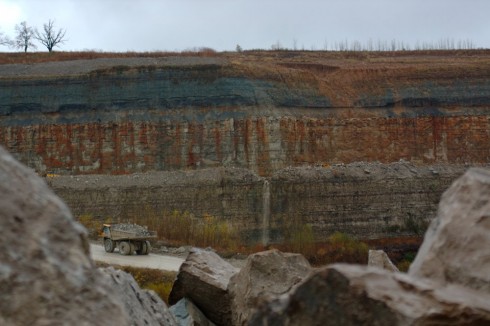
The cliffs of the quarry were stained red. Blood, seeping out from between the bedding planes between layers of rocks, might have left similar traces down the sides of the near-vertical cliffs’ faces. But these stains are actually made of iron.
Rain falling on the land above the quarry, seeps into the ground. There it moves downward through the soil, leaching out some of the minerals there, but going ever downward. Downward until it meets a layer of soil or rock that it can’t get through. Clay layers are pretty impermeable, though in this case it’s a layer of coal. The water can’t move through the near-horizontal coal seam very fast, so instead it moves sideways across, and eventually seeps out onto the cliff face.
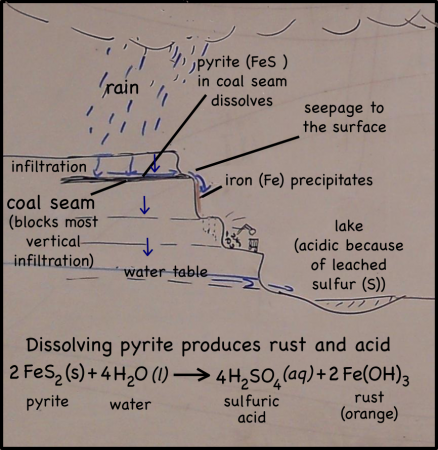
The seeping water still has those minerals it dissolved in the soil. It also has more dissolved minerals from the coal it encountered too. Coal forms in swamps when trees and other plants fall into the waters and are buried before they can completely decompose. Decomposition is slow in stagnant swampy waters because most of the insects and microorganisms that do the decomposing usually need oxygen to help them with their work. Stagnant water does not circulate air very well and what little oxygen gets to the bottom of the swamp-water is used up pretty fast. You could say that conditions at the bottom of the swamp are anoxic (without oxygen), or reducing.

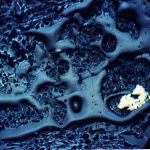
Iron in air will rust as it reacts with water and oxygen — rust is the red mineral hematite (Fe2O3) that you see on the walls of the quarry. Iron in a reducing environment, on the other hand, will form minerals like pyrite (FeS2). According to our guide, the thin coal seam in the quarry has a fair bit of pyrite. In fact, because of the pyrite, the coal has too much sulfur for it to be economical to burn. Like the landfill gas, hydrogen sulfide, burned sulfur turns into sulfur dioxide, which reacts with water droplets in the air to create acid rain so sulfur emissions are regulated.
The water that seeps along and through the coal seam will dissolve some of the pyrite, putting iron into solution. However, the iron will only stay dissolved as long as the water remains anoxic. As soon as the high-iron water is exposed to air, the iron will react with oxygen to create rust. Thus the long stains of rust on the cliff walls show where the water emerges from underground and drips down the cliff face.
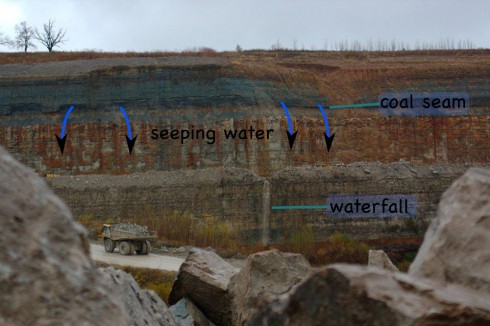
Iron precipitate in other environments

We’ve seen the precipitation of iron (rust) as a result of changes in redox (oxidizing vs reducing) conditions before: on the sandbar on Deer Island in the Gulf of Mexico; in the slow streams along the Natchez Trace Park‘s hiking trails in Tennessee. Iron precipitation is an extremely common process in natural environments, and it’s easily noticeable. Just look for the red.
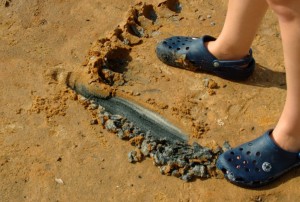
Atlantis Reentry

The last re-entry of the space-shuttle was captured from the International Space Station.
Still life

What makes art? Frank Wilson points out that:
art … never simply transcribes what is “out there,” but selects certain details and arranges them into a harmony that transfigures them.
— Frank Wilson (2010) in “Still life and the alchemy of art“.
We might see arrangements like the stuff sitting on the counter every day, but the image/photography/painting becomes art when the collection is view from a specific perspective that transforms them and highlights details.
Aside from its obvious beauty, what really intrigues me about this picture is where it was taken: In the living room of the Menchers’ apartment, just a few feet from where I was standing. I would never have guessed.
When Eric told me that, I turned and looked, and could see where the vase and the other objects had been placed. But the setting was altogether different from the picture. The living room is a perfectly nice and neat space, and I had just been sitting there, but when I looked at it again there was absolutely nothing about it that would have brought to mind that photo.
Such is the alchemy of art.
— Frank Wilson (2010) in “Still life and the alchemy of art“.
Note: The image at the top of this post is computer generated Gilles Tran, using the free, open-source, 3D rendering program POV-Ray. I’ve played around with POV-Ray and it can be a bit tricky, but you can do interesting things.
Nuclear Fallout: Chernobyl pictures
Just in time for us to start reading The Chrysalids, David Schindler has a frightening gallery from the abandoned surroundings of Chernobyl, twenty-five years after the accident with the nuclear reactor.
The YouTube video below shows the same images as the gallery.
Mushrooms, in detail
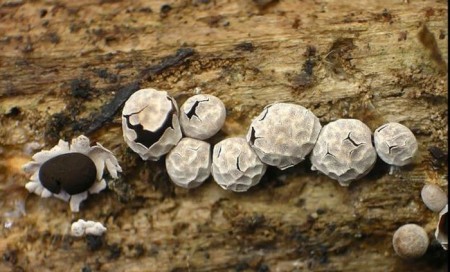
Sometimes beauty is in the details. The World of Technology blog has a wonderful collection of close-up images of mushrooms. One of my students is working on an Independent Research Project on the fungi on our nature trail. Hopefully this might help spark the imagination.